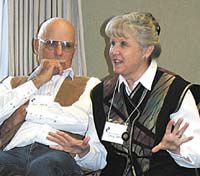| Doc and Connie Hatfield from Oregon Country Beef speak at the summit. |
It was a little like circling the wagons at the recent economic development conference, the Hatfields, Doc and Connie asked participants to sit in a circle. Everyone introduced themselves and their interest in the workshop. Many walks of life were represented in the audience from government to private ranchers. Doc Hatfield is a veterinarian by trade.
Doc and Connie from Oregon Country Beef talked about their organization and how it works. They have worked to allow ranchers to come back to the ranch. Ten young ranch families have come back, “sustainability,” is the key said Connie and with money coming in, the young ranchers are able to return to the ranch. Connie said they attended the extension office meetings, but she just didn’t get it. During that period of time, beef had a bad image with a lot of negative remarks being made about beef.
Connie drove to Bend, Ore. and visited the only fitness gym in town. She asked the owner about red meat. He told you should eat red meat about three times a week, but they had a hard time getting Argentina beef into Bend. These beef are short fed and not fat and raised without hormones or antibiotics. Ace was the fitness friend and he met with the Hatfields and 34 cattle ranchers from throughout the state. Ace was enthusiastic about being able to get natural beef close to home. One of the key components would mean calves would have to be held over to create a year round supply of beef. The combined available total of cattle represented was 10,000 head. Being part of a collaborative effort was a new idea to everyone. Finding a market for the natural beef was important and letting people know where the beef came from and its history was part of the selling point.
Connie went to Portland and asked questions like what form can we put our cows in to fill your need?
She said in agriculture there is seldom a marketing plan. The mission statement for the cooperative group and their goal is to provide sustainable means through the group to provide quality beef while retaining independence. “We fill a market, but one guy can’t do it alone,” said Connie. Country Natural Beef is constantly examined, but it cannot be bought or sold. Each member must donate nine days of labor each year to the company. This can be done in the supermarkets and meeting the consumers to promote the product. The company is a cooperative and there are people on a waiting list to get into the cooperative. The cattle are put up as the capital and the ranchers get paid with the retailer pays. Husbands and wives working together have created a year round supply of cattle. Both fall and spring calving have added to the success and one member has a small feed lot and another the means to truck the cattle to market. Connie jokingly said they rode in a hog truck, but it didn’t seem to matter.
Along the way the Hatfields talked to a marketer who encouraged them to know their cost of production. If animals were to be held over another year, then how much was it going to cost? What are the costs involved in taking the calf to the feed yard, taking it to the packing house? What are your actual costs? How much does the marketer tack on? Put a price on the beef and if the customer won’t pay the price then stop producing it.
Doc told the story of Fran who came to the meetings in his DeLorean sports car, his family ranched but had sold the ranch and Fran went elsewhere and made enough money that he could come back and buy back the ranch. He helped the co-op with their finances and budgets.
Whole Foods will be opening two stores in Salt Lake. This is the grocery chain that markets the Oregon Country Beef. They are looking for producers closer to the store which brings in an Emery County angle for any producers in the area interested in natural beef production.
Connie said she has learned a lot from talking to customers that buy their beef. She even invites customers to come and visit the ranch.
In the cooperative, nobody is in charge and talents are combined to make it a success.
Doc said the ranchers involved all come from an isolated area, but they are a community of shared values. When they get together they have a common bond and purpose. They place cattle 18 months in advance. Their ranchers are receiving 10 cents per pound over market value. Selling to Whole Foods is 60 percent of their market. They send 250 head each week to Texas. Whole Foods is loyal to its customers. Natural markets are responsible to their consumers and they have a good reputation and products to maintain. The Hatfields and their cooperative have found their niche.

